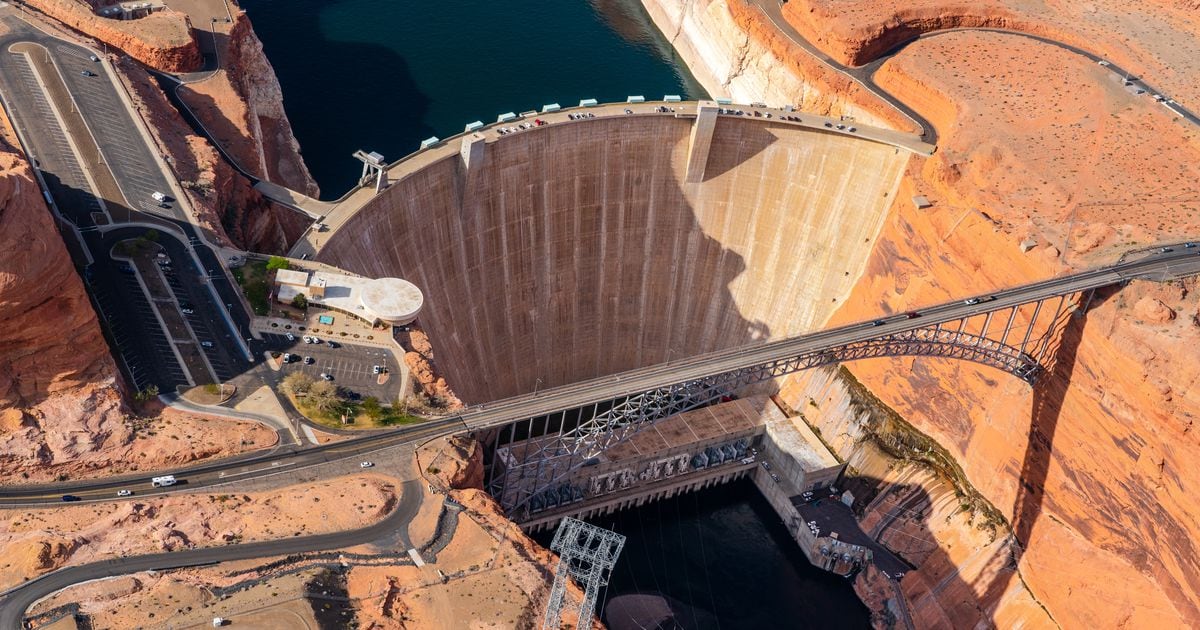Glen Canyon Dam, which creates the second-largest reservoir in the U.S., enables the distribution of Colorado River water throughout the West and generates power for seven states.
It also has a plumbing problem.
Federal officials recently identified damage within Glen Canyon Dam, which creates Lake Powell on the Arizona-Utah border. According to the Bureau of Reclamation, a federal agency that owns and operates dams across the country, four 8-foot-wide steel pipes called the river outlet works have suffered from cavitation — a process that can erode and thin pipes.
The river outlet works were originally intended to release water from Lake Powell when the reservoir was flooding, which hasn’t happened since 1987.
Lake Powell hit a record-low elevation in Feb. 2023, but after a record-setting winter later that year, the reservoir has rebounded — though it is still less than a third of the way full. If dry conditions and overuse persist and the reservoir’s level falls below 3,490 feet above sea level, the pipes would be the only means of delivering water to Arizona, Nevada and California — the Lower Colorado River Basin states. That key elevation is the minimum elevation for hydropower production at the dam, also called “minimum power pool,” and lies below the usual release pipes.
Due to the damage in the river outlet works, the pipes can’t handle high water flows, meaning that Reclamation must send less water downstream through the pipes at low reservoir elevations. That would jeopardize the laws governing Colorado River use, which mandate that the Upper Colorado River Basin states above Lake Powell — Colorado, New Mexico, Utah and Wyoming — deliver a certain amount of water to the Lower Basin states each year.
“The archaic plumbing inside…Glen Canyon Dam is the most urgent water problem facing the 40 million people of the Colorado River Basin,” said Zach Frankel, executive director of the nonprofit Utah Rivers Council.
The reservoir and the dam operations aren’t yet in dire straits. Reclamation projections forecast that Lake Powell won’t dip below 3,490 feet through Feb. 2026, and the agency says it’s working on methods to deliver water downstream at elevations below minimum power pool.
The thinning of Glen Canyon Dam’s river outlet works and resulting water delivery uncertainty at low lake elevations reveal longer-term problems and the need for permanent solutions.
According to Amy Haas, executive director of the Colorado River Authority of Utah, cavitation in Glen Canyon Dam exposes years of mismanagement throughout the whole Colorado River Basin, compounded by higher temperatures and declining flows.
“We need to look back and realize how we got here, which is because use has exceeded the available supply in this basin,” she said. “If we could get that under control, that would go a long way.”
A closer look at the damage

Water from mountain snowmelt in the Upper Basin states flows into the Colorado River, eventually pooling behind Glen Canyon Dam in Lake Powell. Reclamation releases water downstream through the Grand Canyon to Lake Mead.
When Lake Powell is at full capacity, Glen Canyon Dam impounds over 25 million acre-feet of water. One acre-foot of water can sustain two households for one year.
But the reservoir’s elevations have taken a nosedive in the 21st century. It is currently about 32% full, or 3,559 feet above sea level.
Reclamation reports that the agency can “theoretically” release water from Glen Canyon Dam through the river outlet works down to 3,370 feet, an elevation referred to as “dead pool.” At that elevation, 120 feet below the critical hydropower-producing elevation of 3,490 feet, water can no longer flow through the dam with gravity.
function onSignUp() { const token = grecaptcha.getResponse(); if (!token) { alert("Please verify the reCAPTCHA!"); } else { axios .post( "https://8c0ug47jei.execute-api.us-east-1.amazonaws.com/dev/newsletter/checkCaptcha", { token, env: "PROD", } ) .then(({ data: { message } }) => { console.log(message); if (message === "Human



























